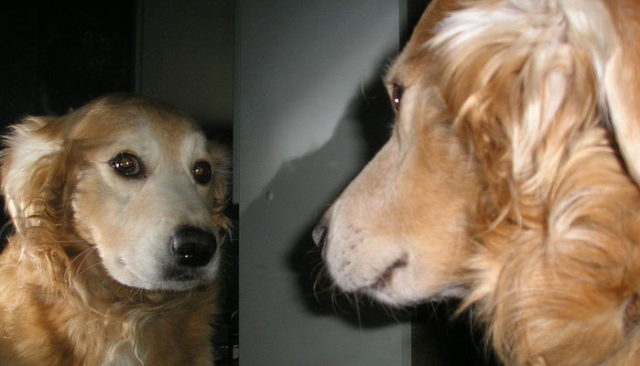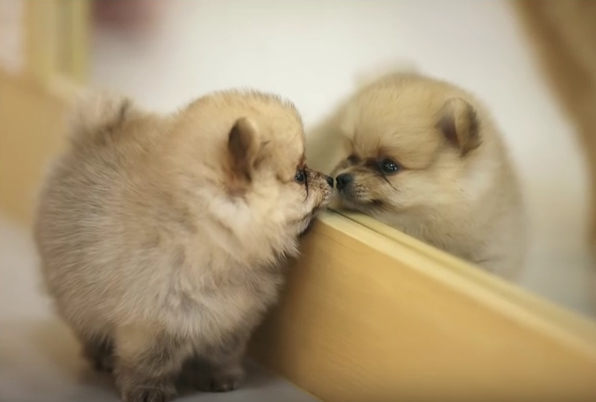
Dogs seem to have more self-awareness than we originally attributed to them, thanks to some new realizations about their perceptions.
As dog lovers, we all have our own ideas about how smart or aware dogs may be, emotionally or otherwise.
We understand that they are emotional creatures. But what does that mean for their ability to understand themselves, or understand their human companions?
Traditionally, science has not given much credit to our canine friends for being deep thinkers. But recent studies show that dogs might have more high-level intelligence than scientists believed.
In fact, researchers recently discovered a group of African wild dogs who conduct democratic votes through sneezing!
But what does that say for self-awareness in dogs?
What Is Self-Awareness?
Self-awareness is defined as the conscious knowledge of one’s own character, feelings, motives and desires, as well as their impact on the self and others.
Dr. Alexandra Horowitz is a psychologist at Bernard’s College in New York City who teamed up with biologist Professor Roberto Cazzolla Gatti from Tomsk State University in Russia. Together, they conducted two experiments at Bernard’s Dog Cognitive Lab.
As you might already know, there is a popular test for self-awareness in humans and other animals called the mirror test. Babies and animals are put in front of a mirror and their reactions are observed.
In a more advanced version of the test, subjects are given some sort of mark using paint or stickers, and put in front of a mirror. If they touch themselves where that mark is in the reflection, they are deemed self-aware, meaning they understand the reflection in the mirror is not another animal or entity. Furthermore, they understand how they are supposed to look and that something is wrong with that image.
We’ve all seen the videos and may have our own personal experience with our pets reacting to themselves in mirrors. It’s hilarious when the dog thinks it’s looking at another dog and starts barking or pouncing, or the cat just doesn’t care at all.

Bonobos, orangutans, and dolphins have passed the mirror test. Researchers are not sure about chimps.
However, dogs have not passed this test and therefore have not been concluded as self-aware animals.
But Dogs Perceive the World Differently
Horowitz and her team remembered a key factor that may have been leading to gross misunderstandings – dogs do not perceive the world through sight, like humans do. They perceive the world through smell.
So, the researchers set to work creating an olfactory mirror instead of a visual mirror. And the results were telling.
Foundations for the Study
This study had some interesting foundations to use as a basis for the methodology.
A biologist named Marc Bekoff noticed in 2001 that his dog was more interested in sniffing the urine of other dogs than his own. This meant that the dog smelled the difference between his own urine and that of others.

Being a scientist, Bekoff conducted his own experiment. Over the course of five winters, he moved around the urine of his own dog and the urine of other dogs in order to see what his dog could and could not recognize. He deemed this his “yellow snow” study.
Bekoff concluded that his dog had a clear sense of self; that maybe he did not have a sense of “I” but did have a sense of “mine.”
Dr. Horowitz used this to start off with, and borrowed from Bekoff’s work. Professor Gatti proposed a “Sniff test of self-recognition.”
RELATED: Dogs Can Smell Many Things – Including Time
Two experiments were conducted by the team. In the first experiment, 36 dogs and their owners were recruited. The dogs were allowed to roam freely within a large pen, and smell any container within the confined area.
One container had their own urine in it, another had a different dog’s urine, and the third had their own urine with an additional scent mixed in.
In the second experiment, 12 dogs were used and the third canister contained a more neutral scent.
In both experiments, dogs showed much more interest in the third canister than the other canisters.
Sniffing Out the Mark
Horowitz believes that this demonstrates similar results to the advanced-level mirror test, where markers are placed on the faces of the subjects. Only in this experiment, the marker is placed on the smell of the subject’s own urine.
The dogs indicated that they knew something was wrong with their own self, but they didn’t know how to fix it.
Horowitz concludes that this demonstrates the dogs are at least somewhat self-aware.
However, Dr. Gordon Gallup, who created the mark test, disagrees with this conclusion. His definition of self-awareness is “the ability to become the object of your own attention.” He says that paying more attention to something doesn’t exactly prove awareness of self.
He supposes that perhaps the dogs just find the smell of the third canister to be more bizarre or otherwise interesting. He also questions the validity of the dolphin mirror tests, saying they aren’t able to reach out and touch the way primates are.
Either way, experts point to this study’s methodology has noteworthy all by itself. It certainly demonstrates scientists’ ability to not apply one species’ standard of perception to all species.
Science is at least advancing enough to understand that just because non-human animals cannot speak or behave as we do, this does not mean they can’t communicate or demonstrate advanced-level intelligence.
Similar realizations were made when it was discovered that primates could communicate with humans using sign language. It resulted in a paradigm shift – we can attribute more feelings to animals when we can understand them and relate to them.
The more science comes to help us understand non-human animals, the better the world will treat these animals in the future.












